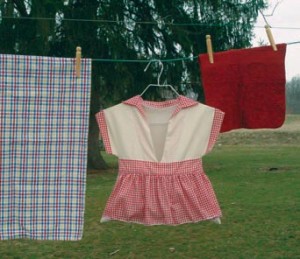From my desk I am overwhelmed with a feeling of gratitude. The window directly views the south side of our  garden. From my viewpoint, I can see three counties of our lovely Ireland today. I am physically in Co. Cavan. I can see my friend Will’s polytunnel up on Corry Mountain, which is on the Leitrim side of our village. Further on the wind turbines on Arigna Mountain in Co. Roscommon are glinting in a milk-washed sunshine.
garden. From my viewpoint, I can see three counties of our lovely Ireland today. I am physically in Co. Cavan. I can see my friend Will’s polytunnel up on Corry Mountain, which is on the Leitrim side of our village. Further on the wind turbines on Arigna Mountain in Co. Roscommon are glinting in a milk-washed sunshine.
The meadow part of the garden is waist high in vegetation. The apple trees have little baby buds that will be delicious fruit in a few months time. I have counted the little green egg shaped buds on the damson tree. The yellow flag, the native iris, is thriving in the soggier section of garden fed by the drainage ditch. The stinging nettles are going wild. And even though they are a weed and I need thick gloves for handling or hacking down, I feel grateful for them too, for they are a sign of soil fertility. The nettles are telling us that we are feeding the soil and in turn the soil feeds us.
The wild strawberries are romping around the edges of the vegetable and flowerbeds. We have a young friend who never tires of harvesting them for us. One for the bowl, one for SÃog’s mouth. These tiny bursts of yumminess are wonderful additions to a rhubarb tart, in muffins or added to a yoghurt smoothie.
As we approach the longest day of the year the earth, the garden, the wild roses and mare’s tails in the hedgerows, are in a frenzy of activity. The life force is so strong. Everything is rejoicing in the long days, the late nights where the bats swoop at 10 o’clock and twilight seems to stretch until midnight.
We have a bench outdoors where we can survey this abundance, listening to the cuckoo calling in early morning and late evening. The perfect dinner aperitif is elderflower cordial diluted with sparkling spring water or seltzer. And then Tony will sigh and joke, “Another fine mess you got me into…”
Tony was saying that this autumn we would plant an elder tree since we love how it gives twice. In June the creamy lace flower heads appear. They are the key ingredients for making elderflower cordial, wine, vinegar or champagne or drying for a tisane. Then in September the flower heads produce tiny berries, much loved by birds but also much coveted by me for elderberry jelly.
For both cordial and jelly making rely on a good large stockpot for the making. A good three-litre stainless steel one is very handy.

Elderflower Cordial
Pick 21 large elderflower heads. Soak briefly in the sink to encourage any animal life to evacuate.
Place the elderflower heads in the stockpot. If you have some fresh lemon balm, put in a couple handfuls of leaves. Chop an unwaxed lemon and place it in the pot. Cover the lot with boiling water. Slam on the lid and forget about it for twenty-four hours.
Next day, sieve the liquid off and discard the flower heads, lemon bits and lemon balm leaves. You will probably have about two litres of liquid. Add the juice of two lemons. Put back on the stove and gradually add a kilo of sugar (about 5 cups – yes, really, it is a preservative and less will effect the keeping quality of the cordial). Stir over a low heat.
When the sugar has dissolved you are ready to bottle up your cordial. Sterilize the jars or bottles first by washing and putting in the oven set to its lowest heat for a minimum of ten minutes.
An essential tool is a funnel that will properly fit the width of your bottles. This is one item where there is no skimping or substituting. Hot cordial on hands is not pleasant.
Cork or seal your bottles. The cordial enjoys a long shelf life unopened. Once opened, store it in the refrigerator.
Herb Tea (or Tisane)
Chamomile and elderflower make a happy herbal medley. They both are out in June (I spotted wild chamomile out in May this year, which is early for us).
Tea herbs need to be dried. Summer humidity can sometimes be the challenge to be met to dry the herbs for storing. In Ireland we have the ‘hot press’, the closet housing the hot water tank. This creates a good atmosphere for drying herbs. Bunch them up; swathe them in muslin and hang them upside down.
Alternatively, you can dry them on a sheet on top of a wood stove or briefly in the coolest part of a kitchen range. If you live in a terribly humid summer climate, you may need to resort to a food drier.
Whatever method you use, once they are dry just stash them in a clean glass jar.
Wild Strawberries
Wild Strawberries freeze well. I freeze them in batches equaling one cup. They also can be dried in a food dehydrator. If you live in a sunny climate, use the rays just as you would for drying tomatoes. However, in Ireland that’s not an option. But then with our cool summer nights we can use the bottom of the oven or range for drying harvests.
Enjoy June’s wild bounty!
































